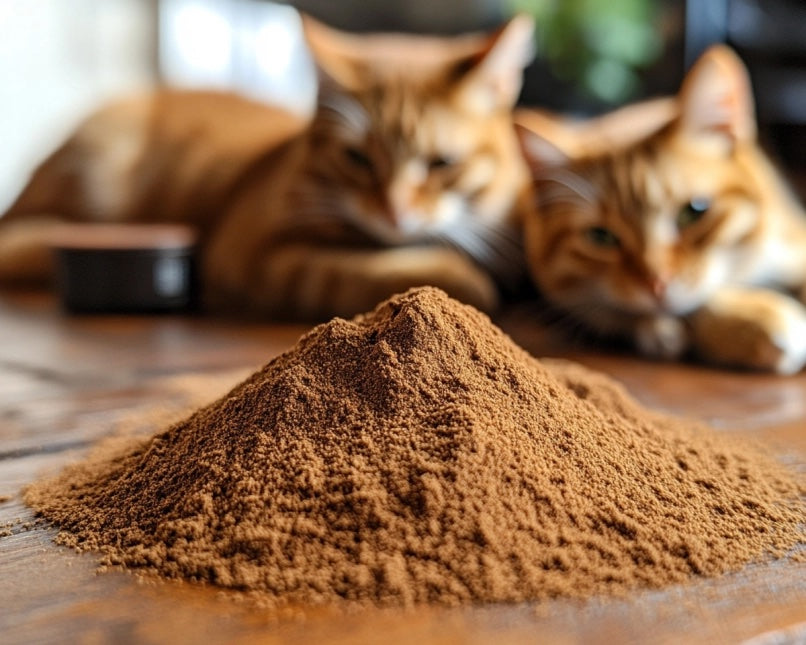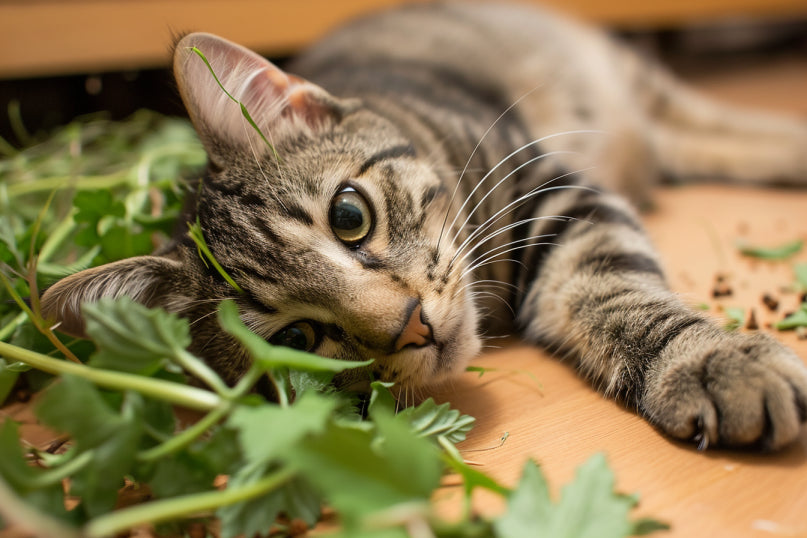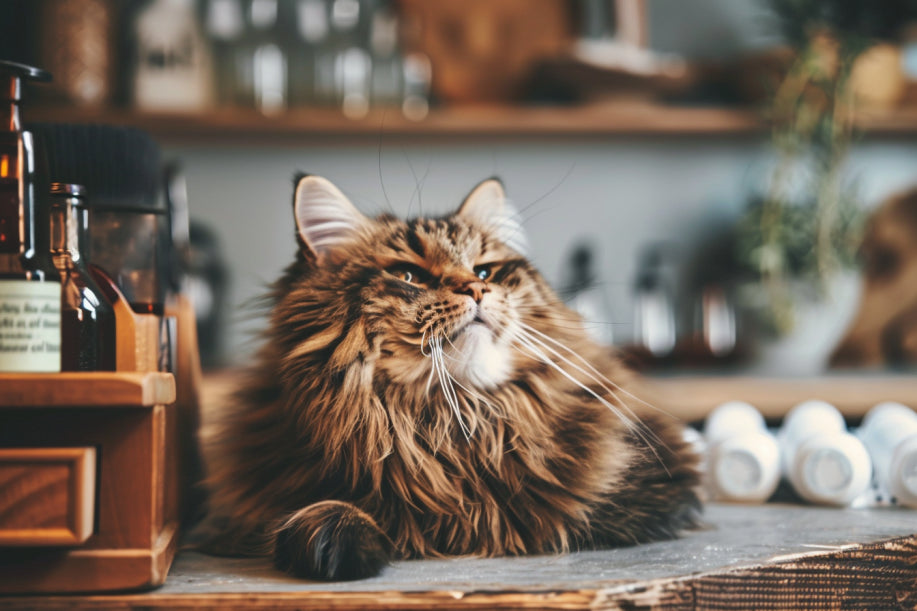
Most cats are notorious food snubbers. That is why cat lovers work hard to find the perfect food to please the pickiest feline palate. Dry cat food or wet cat food? Pâté or Chunky? Chicken or salmon? While the cat food choices are endless, there is another snack for your little meat-eater…cat grass.
Why would my finicky feline eat grass, you may be asking? What is cat grass, and is there more than one type? Are leafy greens safe for my kitty? Here is what you need to know about cat grass.
What is cat grass?
Cat grass is any grass grown specifically to feed cats. It should not be mistaken with catnip. It is not the same as lawn grass. The grass on your lawn (like Bermuda grass or Kentucky bluegrass) might be contaminated with pesticides, herbicides, fertilizers, and parasites.
Cat grass is not a single type of grass. It is typically a mix of alfalfa, barley, oat, rye, or wheat seeds. “Some cats prefer one variety over another. And you can offer a few to determine which they like the best,” says Dr. Jamie Whittenburg, DVM, from Kingsgate Animal Hospital in Lubbock, Texas. “Cat grass may be purchased already grown and ready to eat, or as seeds that you can plant and grow yourself.”
What are the most common types of cat grass?
|
Alfalfa |
Oat Grass |
Wheatgrass |
Barley Grass |
Ryegrass |
|
 |
 |
 |
 |
 |
|
|
Scientific names |
Medicago sativa |
Avena sativa |
Triticum aestivum |
Hordeum vulgare |
Lolium perenne |
|
Nicknames |
Lucerne and purple medic |
Common oat and wild oats |
Bread wheat, liquid gold, green blood, and liquid sunshine |
Common barley, Grain barley, and cereal barley |
English ryegrass, winter ryegrass, darnel, or ray grass |
|
Comes from |
Turkey and Iran |
Europe, northern Africa, and western Asia |
Southeastern Turkey |
The Middle East and the Mediterranean |
Asia, Europe, and northern Africa |
Is cat grass safe?
Cat grass commercially or personally grown is safe for cats to eat in moderation.
"It is essential to start slow with small amounts of grass and see how your cat handles it,” Whittenburg says. “Too much cat grass can cause gastrointestinal issues, such as an upset stomach and vomiting. You also want to make sure that your cat is eating adequate amounts of their regular diet.”
With that said, cat grass is much safer than lawn grass, which might be treated with insect or weed killer. Though cats may confuse cat grass with other common household plants like Aloe vera or lemongrass. Put toxic plants in hanging planters or put them on a high shelf.
Why do cats eat grass?

Cats are obligate carnivores, meaning they need at least 70% of their diet to be meat. But felines also can digest some plant material.
A 2021 study found that 61% of cats nibble on greenery. Before eating cat grass, nine in 10 cats acted normal, without any signs of illness. Interestingly, only 27% of cats were regular pukers.
Researchers no longer believe felines use cat grass as a primitive stomach medicine. But the reasons they eat grass are still unclear. While scientists have not agreed on a single reason yet, here are four possible theories.
 Mental stimulation. Kittens and adult cats may eat cat grass because they are bored. Chewing is not only self-soothing, it releases mood-elevating chemicals called endorphins.
Mental stimulation. Kittens and adult cats may eat cat grass because they are bored. Chewing is not only self-soothing, it releases mood-elevating chemicals called endorphins.
 Parasites. Adult cats may eat grass to jump-start muscles in their digestive tracts. It helps push tapeworms, roundworms, and hookworms from their guts. Kittens eat more cat grass because their immune systems are not strong enough to kill parasitic worms.
Parasites. Adult cats may eat grass to jump-start muscles in their digestive tracts. It helps push tapeworms, roundworms, and hookworms from their guts. Kittens eat more cat grass because their immune systems are not strong enough to kill parasitic worms.
 Vitamins and minerals. Cat grass is full of vitamins and minerals. They include magnesium, iron, manganese, and vitamins A, B, and D. Cat grass also contains folic acid. It is a vitamin that helps create red blood cells. Cat grass is also packed with chlorophyll. The green substance helps freshen your kitty's breath. Before the discovery of antibiotics, chlorophyll also helped cats deal with anemia, infection, pain, skin diseases, and ulcers.
Vitamins and minerals. Cat grass is full of vitamins and minerals. They include magnesium, iron, manganese, and vitamins A, B, and D. Cat grass also contains folic acid. It is a vitamin that helps create red blood cells. Cat grass is also packed with chlorophyll. The green substance helps freshen your kitty's breath. Before the discovery of antibiotics, chlorophyll also helped cats deal with anemia, infection, pain, skin diseases, and ulcers.

 Natural laxative. Because cat grass is 85% water and high in fiber, it is a natural laxative. In the wild, felines eat grass because it helps them throw up the less digestible parts of their prey like fur, bones, or feathers. Likewise, indoor cats eat grass because it helps them digest or puke up hairballs.
Natural laxative. Because cat grass is 85% water and high in fiber, it is a natural laxative. In the wild, felines eat grass because it helps them throw up the less digestible parts of their prey like fur, bones, or feathers. Likewise, indoor cats eat grass because it helps them digest or puke up hairballs.
How do I grow cat grass?

To create a salad bar for your cat, sow the cat grass seeds ¼ inch deep.Then cover them with potting soil. Place the container on a sunny windowsill. And keep it moist at 70°F (or 21 °C).
Your cat grass seeds will sprout in 7-14 days. Once the grass is four inches (10.16 centimeters) tall, it is ready for your fur baby to eat.
Mist the cat grass with water every day, and trim it back to an inch (2.54 centimeters) every other week to promote new growth. When the cat grass turns yellow or wilts, plant a new container.


